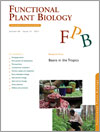
Functional Plant Biology
Volume 38 Number 12 2011
RESEARCH FRONT: Beans in the Tropics
FPv38n12_FO Why not beans?
FP11102 Crop improvement in the era of climate change: an integrated, multi-disciplinary approach for common bean (Phaseolus vulgaris)
Common bean (Phaseolus vulgaris) is an important nutritional crop in many countries of the world where it can provide up to 50% of protein intake. But currently its production is constrained by many factors related to climate change. This article describes a global research plan to maintain the productivity of common for the years to come that utilises resources from throughout the world.
FP11105 Polyols as biomarkers and bioindicators for 21st century plant breeding
New and improved analytical technologies have enabled the characterisation of plant metabolic networks at an unprecedented level of precision. The synthesis and occurrence of polyols offer considerable promise for use as bioindicators and/or biomarkers of plant function. Here we highlight the role(s) of polyols as a significant carbon sink and highlight their potential for use as integrated measures of plant function.
FP11130 Root responses to neighbouring plants in common bean are mediated by nutrient concentration rather than self/non-self recognition
Plants are reported to over-invest in roots in response to neighbours. In bean, phosphorus concentration but not the presence of a neighbour changed root biomass. Root architecture responded to both factors. These results support the hypotheses that resource depletion rather than self/non-self recognition mediates below-ground interactions, and that root architecture can respond to neighbours without changes in root biomass.
FP11124 Investigation of the domestication of common bean (Phaseolus vulgaris) using multilocus sequence data
The study of domestication in plants helps understand the origins and selective pressures on crop species. This study identified two independent domestication events, one in each gene pool of common bean with durations of ~1900 and 1500 years in MA and Andean respectively. With significant population structure, bottlenecks, and varied LD, association mapping is appropriate in each gene pool independently.
FP11164 Non-invasive approaches for phenotyping of enhanced performance traits in bean
Plant phenotyping is an emerging discipline in plant biology and describes the measurements of functional and structural traits to better understand the eco-physiological adaptation of plants to their natural environment. Phenotyping approaches aim for an non-invasive quantification of plant properties by using e.g. fluorescence approaches, spectroscopy and magnetic resonance techniques in combination with advanced image analyses techniques. We propose that quantitative plant phenotyping will help to better understand gene environment interactions and to assist breeding for enhanced resource use efficiency varieties.
FP11137 Salinity drives host reaction in Phaseolus vulgaris (common bean) to Macrophomina phaseolina
Common bean (Phaseolus vulgaris) productivity is often limited by diseases and also by abiotic stress. This study showed that salinity increased severity of the disease caused by Macrophomina phaseolina and results in increased tissue Na+ and Cl–, and decreased tissue K+. This highlights the importance of maintaining the appropriate balance between K+ and Na+ in regions where M. phaseolina is a serious pathogen on common bean.
FP11035 High night temperature decreases leaf photosynthesis and pollen function in grain sorghum
High temperature stress can limit productivity of grain sorghum. This study is aimed at understanding impacts of high night temperatures in grain sorghum. High night temperature increased the reactive oxygen species content in leaves and pollen grains. High night temperatures decreased leaf photosynthetic rates and pollen viability leading to lower seed yield.
FP11135 Opposite changes in leaf dark respiration and soluble sugars with drought in two Mediterranean oaks
We studied how leaf respiration was affected by drought in seedlings of two tree species and found that the decline in respiratory rates with drought was not related to a depletion of soluble sugars. Rather, as respiration declines with increasing drought, the pool of soluble sugars that remains available for other metabolic processes can increase.
FP11145 Groundnut (Arachis hypogaea) genotypes tolerant to intermittent drought maintain a high harvest index and have small leaf canopy under stress
Groundnut yields were tested across varying water stresses. Root length density, rooting depth and water extraction varied but did not discriminate tolerant from sensitive genotypes. Root length density related poorly to water extraction. Intermittent stress tolerant genotypes maintained a high harvest index under stress and had lower leaf weight. Intermittent drought tolerance in groundnut was related to the development of a smaller leaf canopy.



